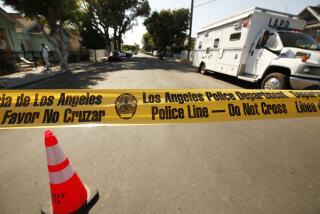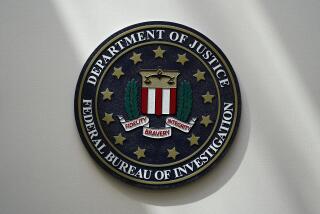Scope of Plots Bush Says Were Foiled Is Questioned
- Share via
WASHINGTON — In the spring of 2003, Los Angeles police officials were summoned to a briefing with the FBI-led Joint Terrorism Task Force and told that the 73-story Library Tower might have been the target of a terrorist plot similar to that of the Sept. 11 suicide hijackings.
When the plot was disclosed last year, authorities said publicly that they had viewed the claims by captured Al Qaeda chieftain Khalid Shaikh Mohammed with skepticism. They said that, at best, the alleged plot was something that had been discussed but never put into action.
By the time anybody knew about it, the threat -- if there had been one -- had passed, federal counter-terrorism officials said Friday.
Still, the broader idea for attacks on West Coast buildings that included the Library Tower was one of the cases President Bush was referring to when he said that three potential terrorist plots within the United States had been “disrupted” since Sept. 11, 2001. In his policy address Thursday, Bush spoke at length about terrorists and their organizations, saying that at least 10 plots had been foiled worldwide by the U.S. and its allies, including plots in the U.S.
White House spokesman Scott McClellan had said a day earlier that Bush’s speech would provide “unprecedented” detail about terrorist threats, some of them never before disclosed.
However, Bush did not detail the foiled plans, and hours later, the White House released a sketchy list of “plots, casings and infiltrations” that had been disrupted or stopped by the United States and its allies since the Sept. 11 attacks. It did not explain whether any of the incidents were new or disclose how advanced the plots were, although most experts said they did not represent plans that had been put into operation.
On Friday, the White House responded to questions seeking clarification on the potential attacks by referring inquiries to the FBI or other counter-terrorism agencies. The FBI referred the questions to the White House.
“I’m not going to have more to say on those matters at this point,” McClellan said.
He said the list of foiled plots had been prepared by “the intelligence community” and was released late in the day, hours after Bush’s speech, because officials needed to make sure the information it contained would not jeopardize national security.
The White House acknowledged that many of the plots cited by Bush were based on previously known information. But it would not comment on whether Bush and his administration had claimed credit for thwarting terrorist plots in the United States that, in reality, had not risen to the level of a “serious” operational plot at all, as some federal counter-terrorism officials maintained.
A case in point, the U.S. counter-terrorism authorities said, is the alleged plot that included the Library Tower.
The White House said Thursday that U.S. authorities disrupted the so-called “West Coast Airliner Plot” in mid-2002, stopping terrorists from attacking “targets on the West Coast of the United States using hijacked airplanes. The plotters included at least one major operational planner involved in planning the events of 9/11.”
The brief White House document offered no details about the timing of the airliner plot, or potential targets. White House officials on Friday confirmed that one of the targets referred to in the document was the Library Tower, which was renamed the US Bank Tower in 2003.
The description of the plot was based on claims made by Mohammed, who has said he was the mastermind of the Sept. 11 attacks, during interrogations after his capture in Pakistan in March 2003. But those familiar with Mohammed’s comments and the alleged plot have suggested that, at most, it was a plan that was stopped in its initial stages and was not an operational plot that had been disrupted by authorities.
In March 2004, the Los Angeles Police Department confirmed that it had been briefed on Mohammed’s statements. “We were made aware of that information last spring,” John Miller, then the LAPD’s top anti-terrorism official, said at the time.
On Friday, Miller -- now the chief spokesman for the FBI -- said only that the LAPD had discussed the matter in depth with the Joint Terrorism Task Force and concluded that whatever plot that had existed in its initial stages already had been dismantled with the arrest of Al Qaeda operatives in Indonesia and elsewhere.
Federal counter-terrorism officials on Friday disclosed for the first time that during his interrogations, Mohammed said he hadn’t completely abandoned the prospect of a second wave of attacks, but had turned the idea over to a trusted aide named Hambali, the chief of operations for an Al Qaeda affiliate group in South Asia, Jemaah Islamiyah.
Hambali, also known as Riduan Isamuddin, in turn is believed to have chosen several men to launch the attacks, including a pilot, and had set aside some money to pay for them, according to one senior counter-terrorism official.
Those men were soon captured, however, and the plot never progressed past the planning stages, according to several counter-terrorism officials.
“To take that and make it into a disrupted plot is just ludicrous,” said one senior FBI official, who spoke on condition of anonymity in accordance with departmental guidelines.
A second U.S.-based plot on the White House list involves the case of Jose Padilla, a U.S. citizen accused by the administration of being an enemy combatant who plotted to blow up apartment buildings. Padilla was arrested in 2002 and is being held by the U.S. military. However, senior law enforcement officials who know about his case said they had not found any indication that the idea had developed into an actual plan.
The White House refused to provide additional information on a third U.S. plot on the list, which it said involved suicide airline attacks on the East Coast. Counter-terrorism officials said they were not certain what the White House referred to.
The White House list also included seven overseas plots, which have been disclosed before and appeared to have been further along than those allegedly planned for U.S. targets.
More to Read
Sign up for Essential California
The most important California stories and recommendations in your inbox every morning.
You may occasionally receive promotional content from the Los Angeles Times.













